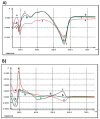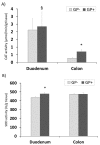Intestinal Absorption and Antioxidant Activity of Grape Pomace Polyphenols
- PMID: 29747456
- PMCID: PMC5986468
- DOI: 10.3390/nu10050588
Intestinal Absorption and Antioxidant Activity of Grape Pomace Polyphenols
Abstract
The absorption and antioxidant activity of polyphenols from grape pomace (GP) are important aspects of its valorization as a feed additive in the diet of weaned piglets. This study aimed to evaluate the presence of polyphenols from GP both in vitro in IPEC cells and in vivo in the duodenum and colon of piglets fed with diets containing or not 5% GP and also to compare and correlate the aspects of their in vitro and in vivo absorption. Total polyphenolic content (TPC) and antioxidant status (TAS, CAT, SOD and GPx enzyme activity, and lipid peroxidation-TBARS level) were assessed in duodenum and colon of piglets fed or not a diet with 5% GP. The results of UV-Vis spectroscopy demonstrated that in cellular and extracellular medium the GP polyphenols were oxidized (between λmax = 276 nm and λmax = 627.0 nm) with the formation of o-quinones and dimers. LC-MS analysis indicated a procyanidin trimer possibly C2, and a procyanidin dimer as the major polyphenols identified in GP, 12.8% of the procyanidin trimer and 23% of the procyanidin dimer respectively being also found in the compound feed. Procyanidin trimer C2 is the compound accumulated in duodenum, 73% of it being found in the colon of control piglets, and 62.5% in the colon of GP piglets. Correlations exist between the in vitro and in vivo investigations regarding the qualitative evaluation of GP polyphenols in the cells (λmax at 287.1 nm) and in the gut (λmax at 287.5 nm), as oxidated metabolic products. Beside the presence of polyphenols metabolites this study shows also the presence of the unmetabolized procyanidin trimers in duodenum and colon tissue, an important point in evaluating the benefic actions of these molecules at intestinal level. Moreover the in vivo study shows that a 5% GP in piglet’s diet increased the total antioxidant status (TAS) and decreased lipid peroxidantion (TBARS) in both duodenum and colon, and increased SOD activity in duodenum and CAT and GPx activity in colon. These parameters are modulated by the different polyphenols absorbed, mainly by the procyanidin trimers and catechin on one side and the polyphenols metabolites on the other side.
Keywords: IPEC-1 cells; UV-Vis spectra; absorption; antioxidant activity; piglets; polyphenols; procyanidin trimers.
Conflict of interest statement
The authors declare no conflict of interest.
Figures










References
-
- Ruggieri L., Cadena E., Martínez-Blanco J., Gasol C.M., Rieradevall J., Gabarrell X., Gea T., Sort X., Sánchez A. Recovery of organic wastes in the spanish wine industry. Technical, economic and environmental analyses of the composting process. J. Clean. Prod. 2009;17:830–838. doi: 10.1016/j.jclepro.2008.12.005. - DOI
-
- Chedea V., Palade L., Rotar M., Călin L., Dragomir C. The anthocyanin composition of a red grape pomace in relation with the wine industry by-products-valorization in animal feed. Lucrări Ştiinţifice Seria Horticultură USAMV Iaşi. 2015;58:29–34.
-
- Zhang H., Tsao R. Dietary polyphenols, oxidative stress and antioxidant and anti-inflammatory effects. Curr. Opin. Food Sci. 2016;8:33–42. doi: 10.1016/j.cofs.2016.02.002. - DOI
MeSH terms
Substances
LinkOut - more resources
Full Text Sources
Other Literature Sources
Miscellaneous

